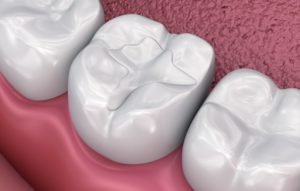
According to the Centers for Disease Control and Prevention, 1 in 4 Americans aged 20-64 has at least one cavity. Fortunately, the advancements in dental technologies and techniques have made treating tooth decay easier. Additionally, you no longer have to have unsightly silver specks in your mouth where the filling was placed. Now dentists can use a tooth-colored material to restore your smile. But the choice is yours on how you want to treat your cavity! Here is how long you can expect various fillings to last and tips on how to get the most out of them.
How Long Do Different Fillings Last?
Now, more than ever, you have many options on how to fill your cavity. Each kind is made from different materials and the lifespan varies for each. Here are the most common dental fillings:
- Composite fillings – These are the most popular option due to the fact they match the natural color of your surrounding teeth and the affordable price. Composite fillings are made from a mixture of ceramic resin and acrylic and can last seven to 10 years.
- Amalgam (silver) fillings – Lasting from six to 15 years, amalgam fillings are made of a mixture of silver, copper, and tin alloy particles.
- Gold fillings – While these fillings do last for 20 years or more, gold fillings are quite costly.
- Ceramic fillings –These fillings are made from porcelain and are even more expensive than gold. You can expect them to last 15 years or longer.
Tips for Extending the Lifespan of a Filling
No dental filling will last forever, but there are things you can do to get the most out of your investment, such as:
- Maintain a good oral hygiene routine – Brushing your teeth twice a day and flossing regularly are the stars of dental health. You decrease the risk of decay or infections that can affect your natural teeth and dental filling by getting rid of bad bacteria and plaque.
- Wear a mouthguard – If you suffer from bruxism (teeth grinding) at night, consider getting a customized nightguard from your dentist. It will help to keep your upper and lower sets of teeth from rubbing against each other and causing damage to your filling.
- Avoid sticky foods – Sticky foods, like jerky, chewy candies, and gum, may pull on your fillings. It’s best to avoid these types of teats so you don’t put your restoration at risk of getting damaged.
- Maintain regular checkups – Visiting your dentist every six months gives them the opportunity to examine your filling to make sure it continues to seal the tooth effectively and offer maximum protection.
Regardless of the type, the fillings of today can easily and effectively repair and restore your natural teeth. Being aware of the lifespan of yours will help you care for it and keep your smile healthy for years!
About the Author
Dr. Thomas Gromling is eager to help treat any of your oral health concerns! He earned his Doctor of Dental Surgery from the Medical College of Virginia at Virginia Commonwealth University and has completed advanced training from various prominent institutions. With over 40 years of experience, he can restore your smile with tooth-colored fillings, so your teeth look flawless and remain healthy. To schedule an appointment, contact him through his website or call (540) 869-4377.
